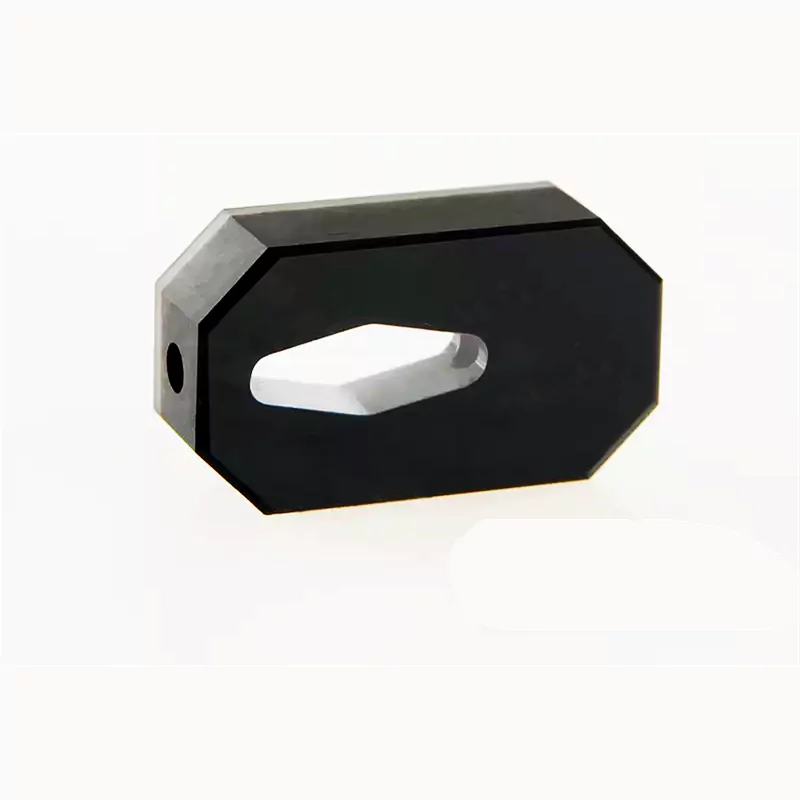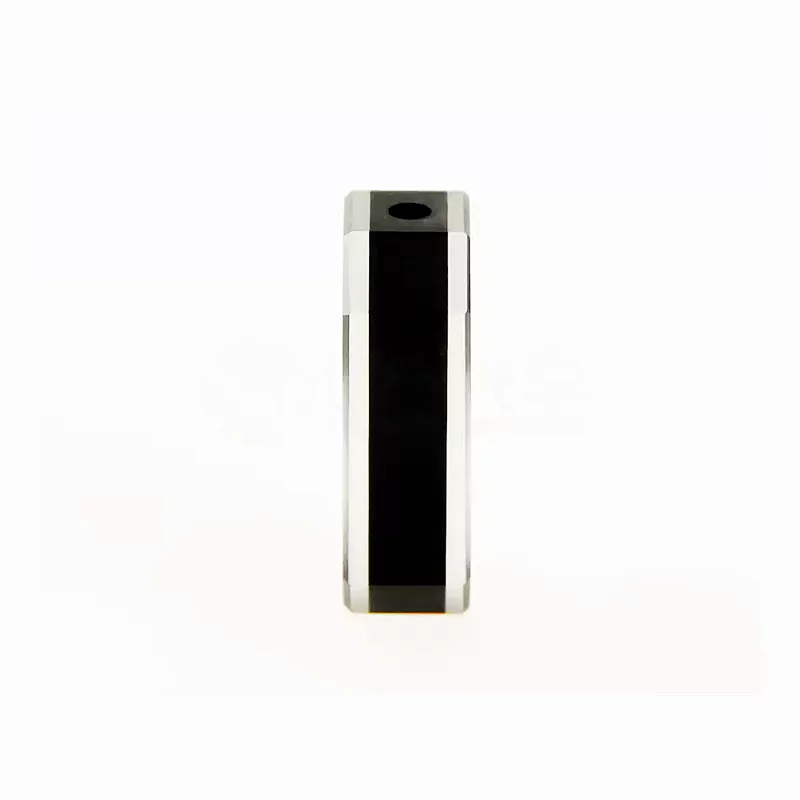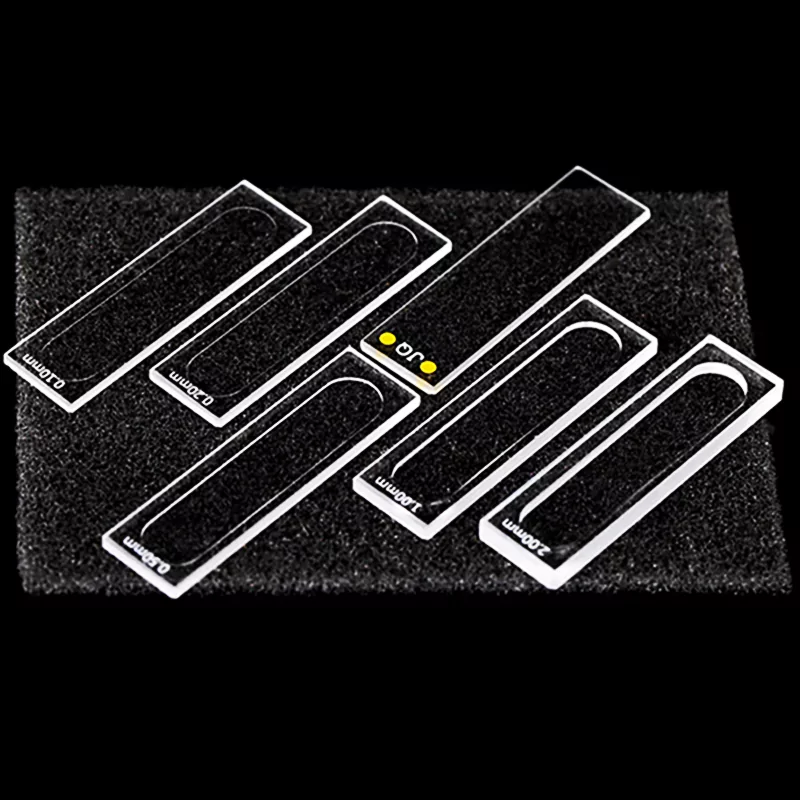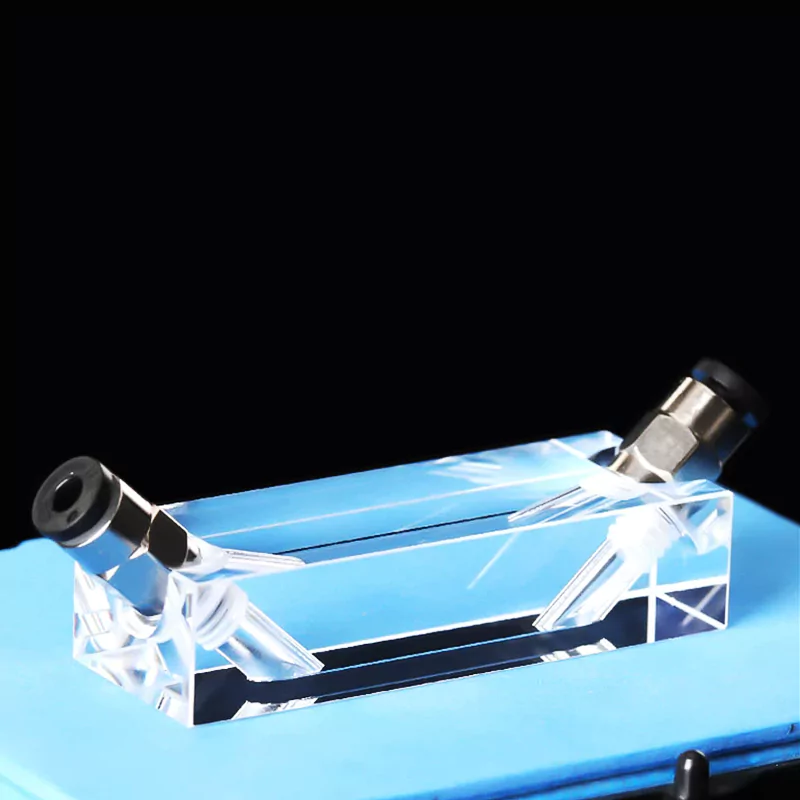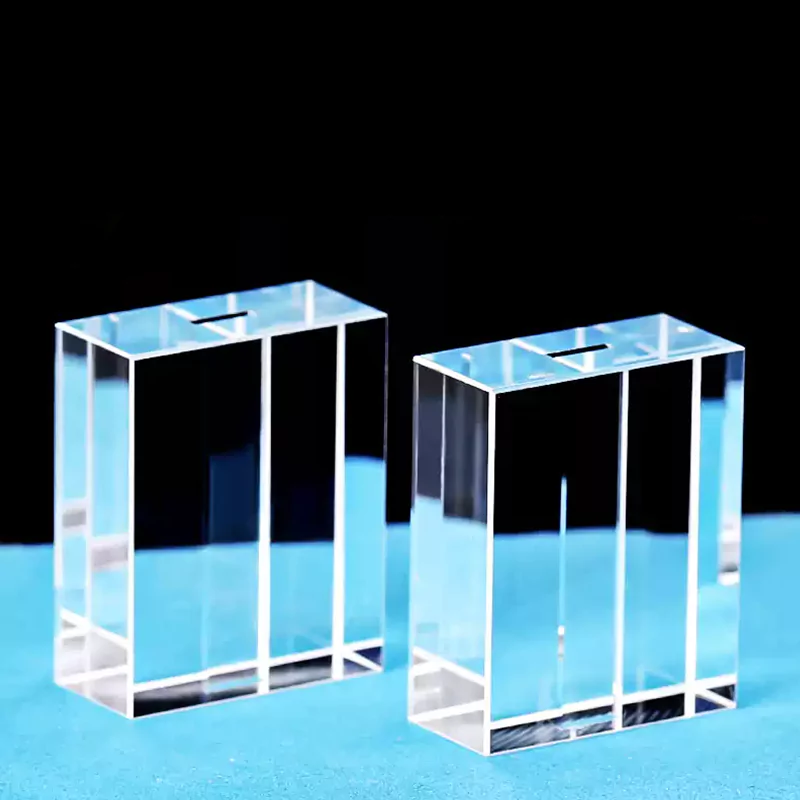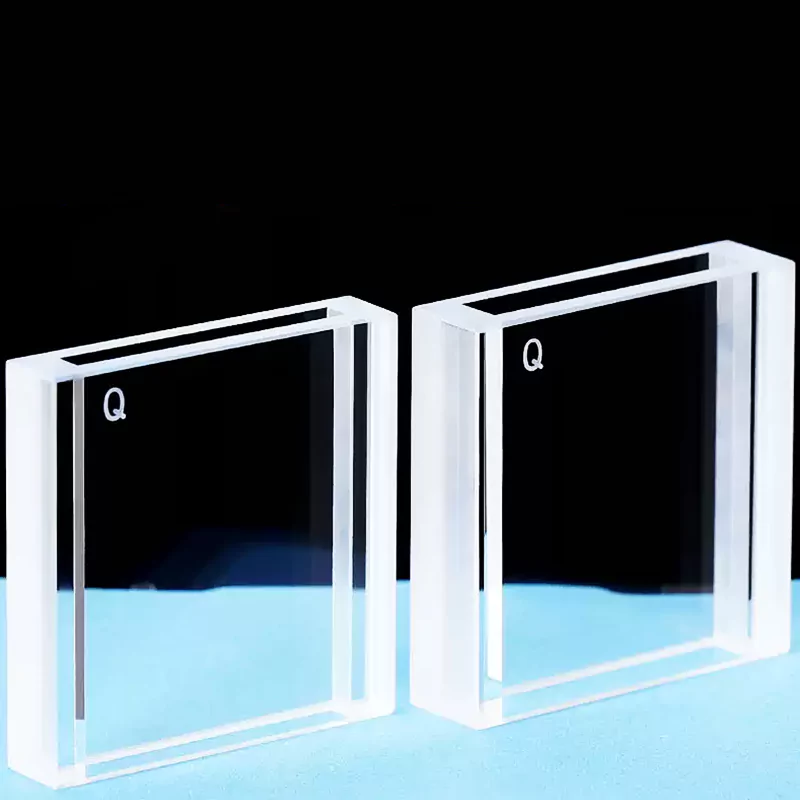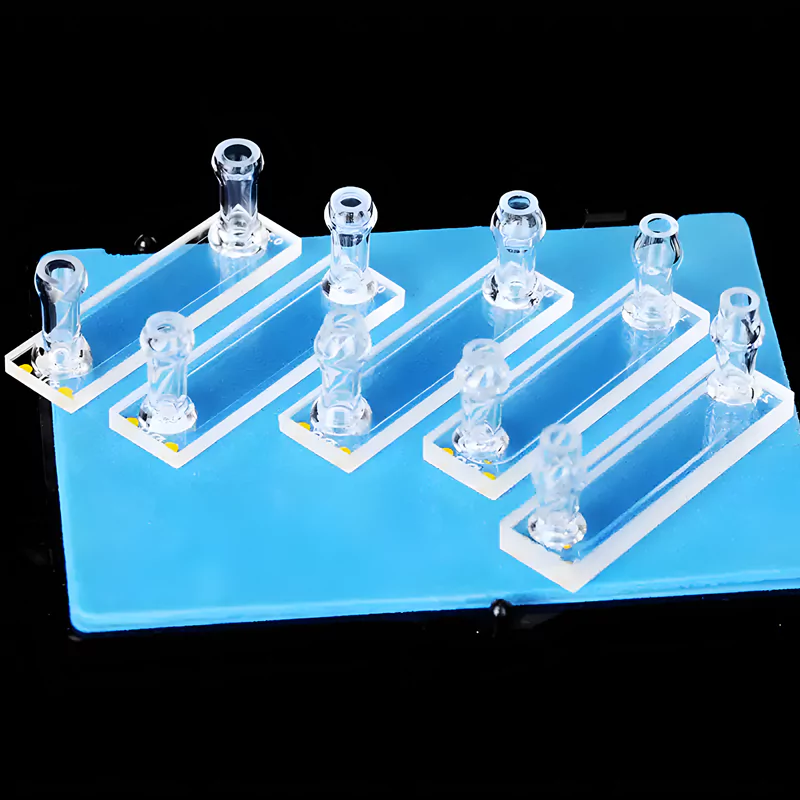- Home
- /
- Types
- /
- Quartz Cuvette
- /
- Quartz Flow-Through Cuvette
- /
- Specialized Rhombus Black-Wall Quartz...
Specialized Rhombus Black-Wall Quartz Flow-Through Cells for Chemical Processing-TOQUARTZ®
Features of Rhombus Black-Wall Quartz Flow-Through Cells
TOQUARTZ® Rhombus Black-Wall Quartz Flow-Through Cell integrates precision optical engineering with durable quartz material, delivering high accuracy and stable performance in demanding spectroscopic applications.
Optical Accuracy
- Black-wall design reduces stray light by up to 90%, ensuring cleaner signals.
- Supports a 5 mm rhombic optical path length for consistent UV-Vis results.
- Transmission range covers 200–2500 nm for broad-spectrum applications.
Material Properties
- Made from ≥ 99.98% SiO₂ quartz, providing exceptional purity.
- Withstands continuous temperatures above 1100 °C without deformation.
- Stable against acids, alkalis, and fluoride gases for reliable use.
Reliable Flow Analysis
- Optimized flow geometry minimizes dead volume for precise sample throughput.
- Compatible with standard M6 or stainless steel connectors for system integration.
- Designed for repeat usage in industrial and laboratory fluid monitoring.

- SiO2 Purity ≥99.98%, up to 99.995%
- Chemical Resistance to Harsh Reagents
- Customization Services Available
Technical Specifications & Dimensions of Rhombus Black-Wall Quartz Flow-Through Cells
Technical Specifications
| Property | Specification |
| Physical Properties | Material Composition: ≥ 99.995% SiO2 fused quartz Density: 2.2 g/cm^3 typical for fused silica Electrical Insulation: Dielectric strength ~250–300kV/cm; resistivity >10¹⁶ Ω·cm |
| Optical Properties | Transmission Range: 200–2500nm with ≤ 0.3% deviation UV Transparency: > 90% at 220nm for 1mm thickness Stray Light Reduction: Black-wall design decreases background by 35–60% |
| Thermal Properties | Continuous Use Temperature: ≥ 1100°C Softening Point: ~166 °C Thermal Expansion Coefficient: 0.55 × 10^-6/K (20–1000°C) |
| Mechanical Properties | Flexural Strength: ≥ 350MPa Young’s Modulus: ~72GPa Hardness: Mohs scale ~6.6 |
| Chemical Properties | Resistance: Stable against acids, alkalis, HF gas, and aggressive solvents Corrosion Stability: Maintains integrity in salt-rich and acidic environments Surface Quality: Optical polishing ensures ≤ 0.3% transmittance deviation |
Size Chart

| Model | Description | Path Length | Wave Length | Outline Dimension |
| AT-BSM-8044 | 5mm Path Length Rhombus Black-Wall Quartz Flow-Through Cell | 5mm | 200-2500nm | 10x5x15mm |
TOQUARTZ® Addressing Analytical Challenges with Rhombus Black-Wall Quartz Flow-Through Cell
Petrochemical Process Monitoring with Rhombus Black-Wall Quartz Flow-Through Cell
Key Advantages
-
Solvent-stable black interior
— Colorfast after 500 toluene/IPA cleanings; baseline drift ≤0.5%. -
High-temperature sealed flow
— Threaded joints hold 0.4 MPa at 120 °C for 8-hour runs. -
Rhombic low-noise path
— 35–60% baseline-noise reduction at 220–260 nm vs clear-wall cells.
TOQUARTZ® solution
A refinery’s 254 nm BTX monitor showed weekly clouding and micro-leaks. After adopting the TOQUARTZ Rhombus Black-Wall Quartz Flow-Through Cell, recalibration events fell 68% over 60 days. RSD across 8-hour shifts improved from 2.8% to 0.9%. Unplanned downtime dropped by 14 hours per month, stabilizing line reporting and cutting operator callouts.
Pesticide Residue Detection in Agriculture with Rhombus Black-Wall Quartz Flow-Through Cell
Key Advantages
-
QuEChERS-compatible optics
— ≤0.3% transmission drift over 100 ACN/H₂O salt runs. -
Trace fluorescence clarity
— ~45% background reduction at 365 nm for carbamate/OPA assays. -
Low-carryover geometry
— ≤0.5% carryover after a single methanol rinse.
TOQUARTZ® solution
A regional lab screened 200 samples/day for organophosphates and neonicotinoids. With the TOQUARTZ Rhombus Black-Wall Quartz Flow-Through Cell, baseline stability held within ±0.003 AU across 500 injections. Mean time to replacement extended from 1 week to 12 weeks. Retest rates fell 22%, improving report turnaround by 18%.
Polymer UV Stability Testing with Rhombus Black-Wall Quartz Flow-Through Cell
Key Advantages
-
UV-endurance optics
— No haze after 100 h at 254 nm, 15 mW/cm²; drift ≤0.002 AU. -
Scatter suppression under aging
— ~50% out-of-band scatter reduction during accelerated UV exposure. -
Thermal-pressure resilience
— Stable at 80–120 °C extraction; joints sustain 0.3 MPa continuous.
TOQUARTZ® solution
A polymer R&D group evaluated stabilizers in PU extracts under 72-hour UV protocols. Using the TOQUARTZ Rhombus Black-Wall Quartz Flow-Through Cell, decay curves achieved R² ≥ 0.998 with no baseline rise. Repeat tests dropped 40%, freeing 12 analyst-hours weekly. Long UV runs completed without cell discoloration or seal failures.
Customization Solutions for Your Specific Applications
Black-Wall Modifications
Custom wall treatments enhance signal clarity and reduce stray interference.
-
Coating Method
— Applied finishes optimize fluorescence and absorbance accuracy. -
Light Control
— Adjustments reduce background scatter under continuous monitoring. -
Wall Texture
— Finely polished surfaces support consistent transmission stability.
Rhombic Chamber Adjustments
Tailored rhombic geometry ensures flow stability and improved sample interaction.
-
Flow Dynamics
— Configured design improves uniform sample distribution across path. -
Chamber Shape
— Adjustments enhance measurement accuracy for complex solutions. -
Signal Uniformity
— Optimized geometry reduces baseline drift in repeated assays.
Flow-Through Integration Options
Flexible flow designs enable compatibility with varied industrial and lab systems.
-
Connector Choice
— Options ensure secure integration with liquid handling units. -
Seal Design
— Engineered seals maintain leak-free performance during long cycles. -
System Fit
— Adapted layouts align with specific spectroscopy instruments seamlessly.
Product Usage Guideline
Installation and Setup
- Align the rhombic path with the instrument’s beam axis before use.
- Tighten threaded connectors evenly to prevent leakage or misalignment.
- Flush the cell with deionized water to clear dust or residual particles.
Storage and Handling
- Store in a sealed container within a dry, dust-free environment.
- Keep away from direct UV exposure to prevent surface deterioration.
- Handle with gloves to avoid fingerprints and accidental contamination.
Cleaning and Maintenance
- Rinse with distilled water immediately after each analytical cycle.
- Use approved mild solvents to remove residues without damaging surfaces.
- Avoid abrasive methods that can scratch optical windows or black walls.
Troubleshooting and Care
- Check for trapped bubbles if unexpected absorbance shifts appear.
- Inspect seals and connectors regularly for wear or alignment issues.
- Replace sealing components when leaks or flow instabilities are detected.
Optimize Results with Rhombus Black-Wall Quartz Flow-Through Cell
Contact us to discuss your project requirements with our technical team.
Why Partner with TOQUARTZ
Direct Factory Advantage
As a direct manufacturer, we can cut out the numerous intermediate links.
Engineering Expertise
Technical team guides clients from material selection to design optimization, translating specs into deliverables.
Flexible Manufacturing
Handling standard & custom orders via small-batch expertise and prototyping rigor to meet urgent deadlines.
Quality
Assurance
Pre-shipment 3-step validation:
1. dimensional accuracy,
2. material purity ,
3. performance thresholds
Global Supply Chain
Reliable global logistics to industrial hubs (DE/US/JP/KR priority) with trackable milestones.
Releted Products
As a specialized manufacturer with direct factory capabilities, TOQUARTZ provides both standard and custom quartz solutions with engineering support throughout the specification and implementation process.
FAQ
Q: How does the flow-through design of the Rhombus Black-Wall Quartz Flow-Through Cell improve efficiency in continuous assays?
A: The flow-through structure allows real-time monitoring without the need for repeated sample loading. This reduces sample handling errors and improves throughput. In pharmaceutical dissolution testing, the Rhombus Black-Wall Quartz Flow-Through Cell enables uninterrupted absorbance measurement throughout the experiment.
Q: Does the Rhombus Black-Wall Quartz Flow-Through Cell support fluorescence detection applications?
A: Yes, the black-wall design is particularly useful for fluorescence because it absorbs stray light. This prevents unwanted reflections that can mask weak fluorescence signals. Users applying the Rhombus Black-Wall Quartz Flow-Through Cell for food or environmental fluorescence testing report significant improvements in detection sensitivity.
Q: Can the Rhombus Black-Wall Quartz Flow-Through Cell handle corrosive solvents in continuous flow analysis?
A: Yes, the fused quartz structure resists acids, alkalis, and organic solvents. This resistance makes the cell suitable for aggressive sample environments, where polymer or glass cells often fail. The Rhombus Black-Wall Quartz Flow-Through Cell maintains both structural integrity and consistent optical performance.
Q: Why is the rhombic chamber shape important in the Rhombus Black-Wall Quartz Flow-Through Cell?
A: The rhombic geometry improves liquid flow distribution across the optical path. This reduces bubble formation and uneven sample exposure to light, common issues with rectangular chambers. As a result, the Rhombus Black-Wall Quartz Flow-Through Cell provides more stable absorbance data over long assays.
Q: How does the black-wall design of the Rhombus Black-Wall Quartz Flow-Through Cell improve UV-Vis analysis?
A: The black-wall structure suppresses stray light that often creates background noise in UV-Vis absorbance. This allows for clearer baseline readings and higher signal-to-noise ratios. Laboratories using the Rhombus Black-Wall Quartz Flow-Through Cell typically report improved repeatability when analyzing trace-level samples.
Contact our engineering team for technical consultation and pricing. We’ll help you select the optimal specifications for your application requirements.


